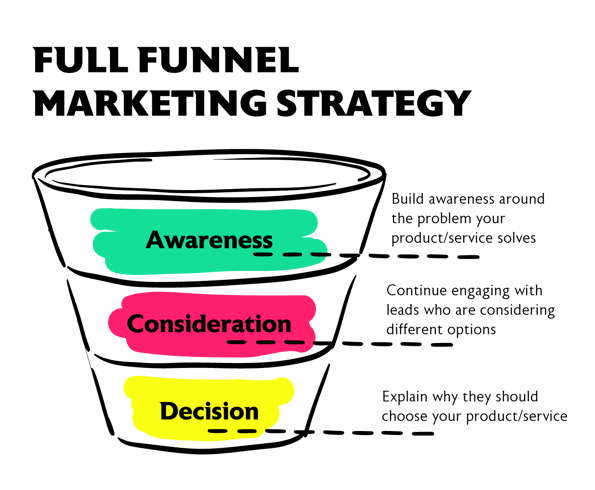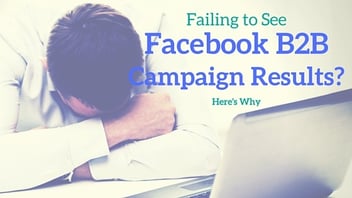-2.jpg?width=920&height=400&name=B2B%20PPC%20Campaign%20Strategy%20That%20Works%20(1)-2.jpg)
B2B PPC Campaign Strategy That Works
A well planned B2B PPC strategy, when crafted with your target audience’s needs, concerns and pain points in mind, can create effective awareness around brands, products and service offerings. This, however, is only true when keeping your target audience in mind every step of the way - or funnel. In this blog, we’ll delve into how you can derive maximum marketing return on investment (ROI) from a measured and customer-focused paid user acquisition campaign.
The fundamentals of a successful B2B PPC campaign strategy
While there are many alternatives in B2B PPC campaigns, and “it depends”, stands true here also, there are several fundamental steps that your paid campaigns can not skip.
1. Define your target audience and persona
Who exactly are you targeting? Which companies from which industry? Or is it a specific company size? Who within the company? The CIO or the research analysts on her/his team?
You need to figure out who can make buying decisions or would be part of the buying committee in order to build a successful B2B PPC strategy. Research their pain points and what keeps your target audience up at night; what they dream of changing and what motivates them to do so. Explore the jargon and professional terminology used in their everyday conversations. The more granular you get and the wider knowledge you have about their pain and how your product/service can help, the clearer (and then more successful) your PPC campaign strategy. More about that in section 2.
Target audience = broad, dry information about the group/s you are targeting. A few ways by which you can segment your target audience:
- Firmographic segmentation - Segmenting your audience based on the size and revenue of their company, as well as the industry they’re in. Large enterprises won’t have the same needs (and means) as small businesses. Startups might be first looking for essentials, while established companies will be more open to scaling and innovating;
- Demographic segmentation - Dividing your audience based on variables like age, gender, education level, job role, and income. You’ll use a completely different language to attract Millennials vs. older generations;
- Geographic segmentation - Dividing your audience based on their location (whether urban or rural, big city, specific country, etc.) enables you to customize campaigns to local cultures, trends, and needs;
- Life cycle stage segmentation - Diving your audience based on where they are in the funnel. Content will differ greatly for each of the cycles, but we’ll get to that in a second…
Persona = getting more ‘personal’ about the specific people who are part of your target audience. For example:
- Demographics - age, gender, location, education, job title, income, family status, lifestyle, where s/he consumes information for work/leisure
- Pain points/use cases your product/service could address - needs, motivations, limiting factors, KPIs
Note that the use cases and pain points your product addresses should start broad and then narrow down into the specifics of each persona. For example, a Project Management tool is useful for many different personas within the organization. The CFO would have differing pain points to a web developer and using the same tool would help both in different ways.
|
Target audience |
Persona |
|
General set of characteristics shared by a group of people you’re trying to target |
Very detailed representations of fictional buyers |
|
Focus on facts (general demographics or behaviors) |
Bigger focus on psychographics (what motivates users to convert and challenges they might approach) |
|
More general, wider messaging |
Better personalization |
|
Help define the overall market for your product |
Allows for better understanding of and emphasizing with your customers’ needs |
You will (or should) use these characteristics and insights when creating a campaign plan and creatives later on by using language familiar to your audience. When you know the industry they work in, try incorporating specific terminology and jargon in your ad copy and landing pages to appeal to the expertise of your target audience. Show them you understand their world and can provide relevant solutions. In the sea of ads, strong and compelling language will make your ad stand out.
2. Determine your current customers’ pain points
Don’t think of your paid campaigns as a sale opportunity, but rather a solution to a problem that’s been troubling your audience forever. Gather data on those nagging problems—could be inefficiencies, outdated solutions, pricing or speed of alternatives.
These challenges and concerns can be discovered through a variety of methods. They may be as direct as surveys to current clients or as indirect as an exploratory trawl through industry forums. Social listening tools are also particularly useful for monitoring conversations about your industry and brand, but the best method is speaking to your current customers and prospects directly. Ask them about their thinking processes when it comes to choosing your product over another; what made them select it, who was involved in the decision-making process, what would make them switch and how the search would look.
If you can’t speak to your clients directly, ask your sales team for the most frequent questions they get asked by your prospects.
Keep an ear to the ground, and you’ll quickly learn what concerns your customers. Your PPC campaign strategy should echo these concerns, resonating with the soul of your customer. If your client comes across one of your campaigns, s/he should immediately think, “yes, that’s me”.
3. Keyword research
A paid campaign is only as effective as its keywords–whether you plan to include Google ads in your campaign or not. Before you start creating content, you need to choose high-quality keywords to ensure the greatest ROI on virtually any online campaign.
Keyword research will help you understand what type of content your target audience is searching for (and using what terms) and should reveal three essential elements: relevance to product, keyword search (higher search means bigger interest) volume, and competition. You want keywords that ensure a relevant user search journey, get searched for frequently, and have relatively low competition. But, you also need to ensure that they drive the right traffic based on informational search intent.
Keyword research tools, such as Hubspot’s Keyword Tool or Semrush, help companies refine their SEO strategies and build more effective marketing campaigns, blog pages, websites and other digital assets–which only boost your B2B PPC strategy. If you want to know what your competitors are up to and find the most profitable keywords, or even eliminate the least effective ones, tools such as SpyFu provide powerful keyword research, PPC campaign optimization and ranking increase functions by indexing billions of results from millions of domains.
But, don’t forget your holy grail – Google Search Console. Inspect it with a fine tooth comb to see how folks are reaching your website right now, which terms they are searching, which pages are attracting them etc. Measure your keyword and cluster performance over time, and evaluate these insights to improve your B2B PPC approach.
4. Design a Full Funnel campaign plan
Now that you have your target audience segmented and understand their pain points, it’s time to design a full funnel campaign plan. This involves creating ad groups or campaigns specifically for each stage of your buyer’s journey (awareness for top of the funnel, consideration for middle of the funnel and decision making for bottom of the funnel), and tailoring the messaging and visuals to address their specific pain points.

Here's what you want to keep in mind while creating content for different stages of your full funnel campaign
Top of the Funnel (Awareness Stage)
Here, your audience is just starting to recognize they have a problem that needs solving. Content should be educational and broadly informative. Think blog posts that outline industry challenges, infographics that display trends, or short videos that introduce the problem your product solves. This isn't the stage for hard sells; it's about nurturing interest and educating your prospective clients.
Types of content we recommend focusing on:
- SEO – make it easier for people to find your company when they google specific terms;
- Content marketing – this is your opportunity to show your expertise. Think of all the how-tos people might be wanting answers for and share your knowledge;
- Social media marketing – Last year, 81% of surveyed people reported they believe social media boosts business’ accountability. You’ll want to build a community that wants to engage with you, which will allow you to reach more people and appear more reliable;
- Influencer marketing – working with influencers is a great way to engage with new audiences, but don’t just go with anyone famous – their followers should be suitable to your brand.
Middle of the Funnel (Consideration Stage)
At this point, your potential customers are evaluating their options for solving their problems. Content here should position your product or service as a solution. Case studies, comparison white papers, and detailed guides that demonstrate your brand's authority and the effectiveness of your solutions work well. Webinars are extremely effective in this phase, as they allow for a deeper dive into the matter while providing the human touch of real-time interaction.
Other types of content you’ll want to create:
- Ebooks – this is a great opportunity to show your brand as experts in your field, plus if you gate the content for lead generation activities on LinkedIn, you get a database of potential customers you can follow up with;
- Email marketing – now that people know what your brand does, it’s great to interact more. Share knowledge, present your brand, but remember your content should be relevant to their interests/pain points.
Bottom of the Funnel (Decision Stage)
Now, your leads are ready to make a decision. Content in this stage should be aimed at converting them into customers. Free trials, live demos, detailed product brochures, and compelling testimonials that alleviate last-minute concerns are crucial. Personalized email sequences highlighting unique selling propositions or offering special deals can also make a big difference in pushing those on the fence to make a purchase decision.
We also recommend:
- Remarketing – Interact with users who have visited your content offer landing page or website, engaged with your ads, watched your videos, listened to your podcast, read your blog, attended your webinar, and, of course, have downloaded your content... But don’t go with the same message, create something unique for them.
Keep in mind that creating targeted content doesn't mean starting from scratch every time. Repurposing existing content can save time and effort while still effectively addressing the needs of your audience at each stage.
Finally, you have to determine which content offers have led to the greatest number of interactions between your brand and your target audience. Look at the success rate of both paid campaigns and the conversion assets themselves. How many people clicked on the ad? How many downloaded the content? How many requested a demo? Look at all these to determine which elements are best performing and amend those that aren't. The best B2B campaigns are constantly analyzed and tweaked to deliver an even better ROI.
Successful B2B PPC campaign metrics
Your B2B PPC campaign is only as successful as the metrics you choose to track. In B2B, conversions, cost per acquisition (CPA), cost per opportunity (CPO) and return on ad spend (ROAS) are king. These PPC campaign KPIs give a pulse on the campaign's efficiency, growth, and ultimate worth to your B2B strategy:
- Click-Through Rate (CTR): It's the bread and butter of any paid campaign! A high CTR means your ads are more than just eye candy; they're the rock stars of the search results, seducing those clicks like a charm.
- Quality Score: It’s almost as if Google's giving you a grade. A stellar Quality Score can lead to lower costs and better ad positions. Remember, quality trumps quantity every time.
- Conversion Rate: So, your ad got a click, now what?? The conversion rate tells you exactly how many clickety-clicks turned into valuable leads or sales.
- Cost Per Conversion: Lower cost per conversion equals more bang for your buck.
- Return on Ad Spend (ROAS): It's the ultimate measure of your B2B PPC campaign's profitability.
Again, evaluate your paid campaign performance not just on the click volume, but on the quality of clicks—which ones are more likely to convert, which ones are merely window shoppers. Use these insights to refine your targeting, your messaging, and your arsenal of conversion assets, all that to end with a successful paid campaigns for B2B campaign.
No content, no PPC campaigns
We cannot stress this enough, B2B PPC and inbound marketing are NOT mutually exclusive. They are symbiotic, each one nourishing the potential of the other. Informative ads lead to content-rich landing pages which feed into compelling email campaigns—creating an ecosystem where conversions are almost inevitable.
Even more, a thoughtful SEO-driven content strategy can have leads come to you, rendering paid campaign as the top-up rather than the top-shelf of your B2B marketing strategy.
If you would like to learn more about PPC campaigns for B2B and how B2B paid lead generation can be optimized for your inbound marketing campaigns, get in touch with one of our marketing experts today.






